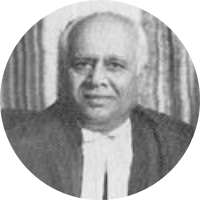K.N. Singh

K.N. Singh
Former Chief Justice of India
Assumed Office25th Nov, 1991
Retired On12th Dec, 1991
Previously
Judge of the Supreme Court 10th March 1986 - November 25th 1991
Permanent Judge of the Allahabad High Court25th August 1972 - 9th March 1986
Additional Judge of the Allahabad High Court August 25th 1970 - 24th August 1972
Advocate General for Uttar Pradesh State GovernmentMarch 3rd 1970 - May 3rd 1970
Profile
Justice Kamal Narain Singh was born on 13 December 1926. He received his education from L.R.L.A. High School in Sirsa, and graduated from the University of Allahabad. He was enrolled as an advocate in the Allahabad High Court on 4th September 1957. As a lawyer, he took up Civil, Constitutional, and Taxation matters in Allahabad. He was first appointed as the Junior Standing Counsel, and then the Senior Standing Counsel for the Uttar Pradesh State Government on 24 April 1967. He was the Advocate General for U.P. from 3 March 1970 to 3 May 1970.
His career as a judge started with his appointment as an Additional Judge of the Allahabad High Court in 1970. After two years, he was made a Permanent Judge on 25 August 1972. He was elevated as a Supreme Court Judge on 10 March 1986. After almost 5 years, he succeeded Justice Ranganath Misra to become the 22nd Chief Justice of India from 25 November 1991 to 12 December 1991. His term was only for 17 days, making him the shortest-serving Chief Justice of India. Post his retirement, he became the Chairman of the 13th Law Commission of India which was established in 1991 and stayed in office till 1994.
During his 5 year tenure at the Supreme Court, Justice K.N. Singh authored 100 judgments and was a part of 336 Benches.
Most of his judgments were on Service (32) and Constitutional law (18) matters.
Notable Judgements
In M.C. Mehta v. Union of India, also known as the Ganga Pollution Case, was one of the first river-pollution cases brought to the Court as public interest litigation. The two-judge Bench presided over by Justice K.N. Singh noted that despite the provisions in the Water (Prevention and Control of Pollution) Act, 1974 and The Environment (Protection) Act, 1986, neither the State authorities nor the Central Government had taken any effective steps to stop the discharge of industrial waste in the river. The Bench ordered the tanneries to set up primary treatment plants, as a minimum. In a further order, it was also directed that licenses to establish new factories should be refused if they did not have an adequate waste treatment plan.
In Shasi Nayar v. Union of India, the constitutional validity of the death sentence was challenged. The method of execution of the death sentence by hanging was also challenged. Justice Singh held that capital punishment had a social purpose - the country was not ready for its abolition as it had a deterrent effect. He also held that execution of death sentence by hanging was reasonable and not violative of Article 21. It was scientific and one of the least painful methods of execution.
Justice K.N. Singh was also a part of the five-judge Bench in Charan Lal Sahu v. Union of India. The constitutional validity of the Bhopal Gas Leak Disaster (Processing of Claims) Act, 1985 was challenged. Under the Act, the Central Government assumed power to represent all the victims of the disaster in all cases. The Bench held that the Act was constitutional: the government was merely facilitating the proceedings, and not adjudicating it, to make it easier for the victims who might not be capable to represent themselves fairly.
